Home / All Recipes / Indonesian / Wajik - Sticky Rice in Palm Sugar and Pandan Leaves
Wajik - Sticky Rice in Palm Sugar and Pandan Leaves
Learn how to prepare wajik (Indonesian sticky rice cakes) with only 4 ingredients: white sticky rice, coconut milk, palm sugar, and pandan leaves. Vegan and gluten-free.
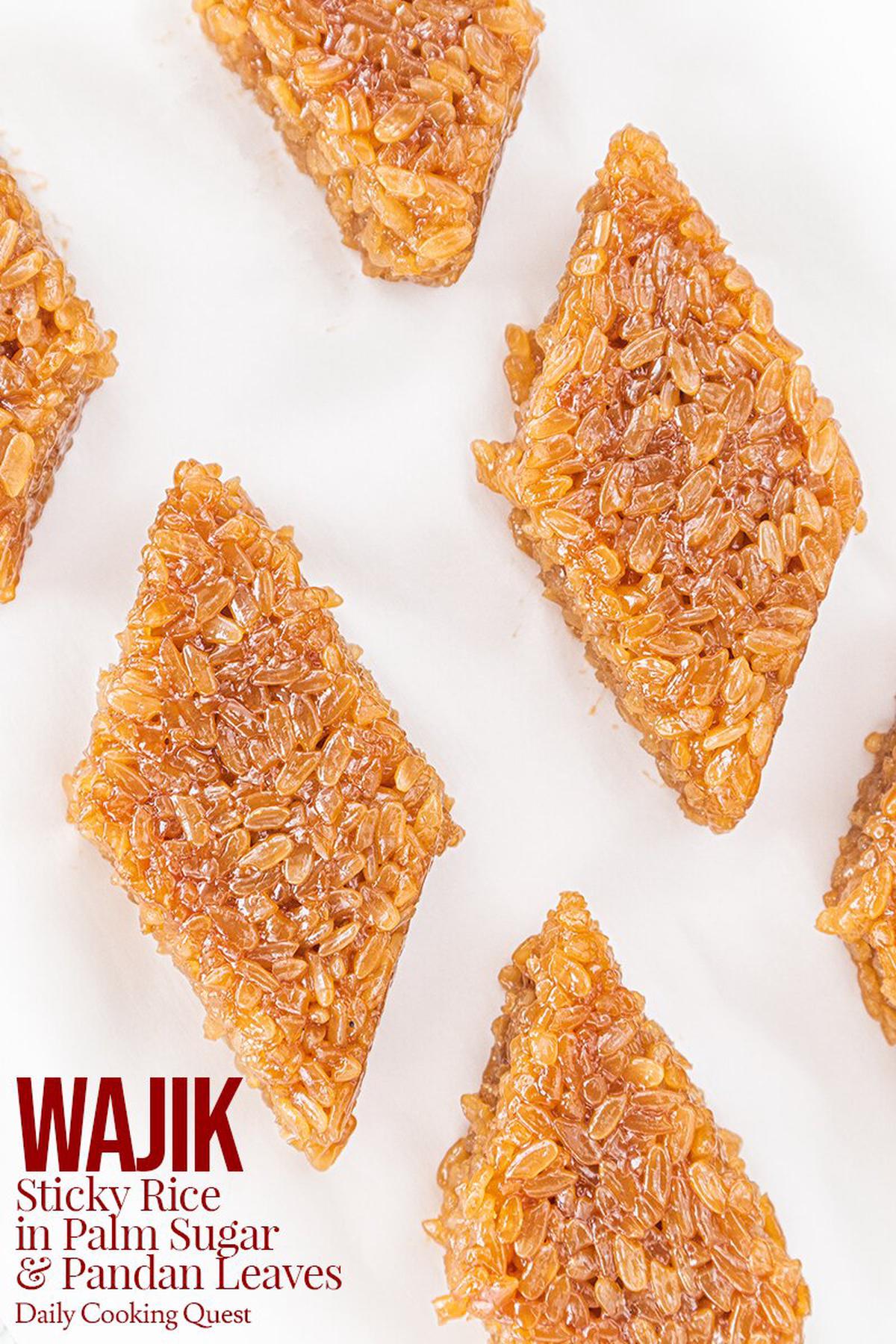
Wajik is a traditional Indonesian snack/cake made with steamed glutinous (sticky) rice and further cooked in palm sugar, coconut milk, and pandan leaves.
The cooked rice is then spread and flatted in a baking tray. Once it cools to room temperature, we cut this into small pieces in the shape of a diamond (er, okay, a rhombus or a parallelogram to be geometrically precise).
Incidentally, in a card game, the diamond is translated as a wajik. So, you are not supposed to cut your wajik into squares. ♥
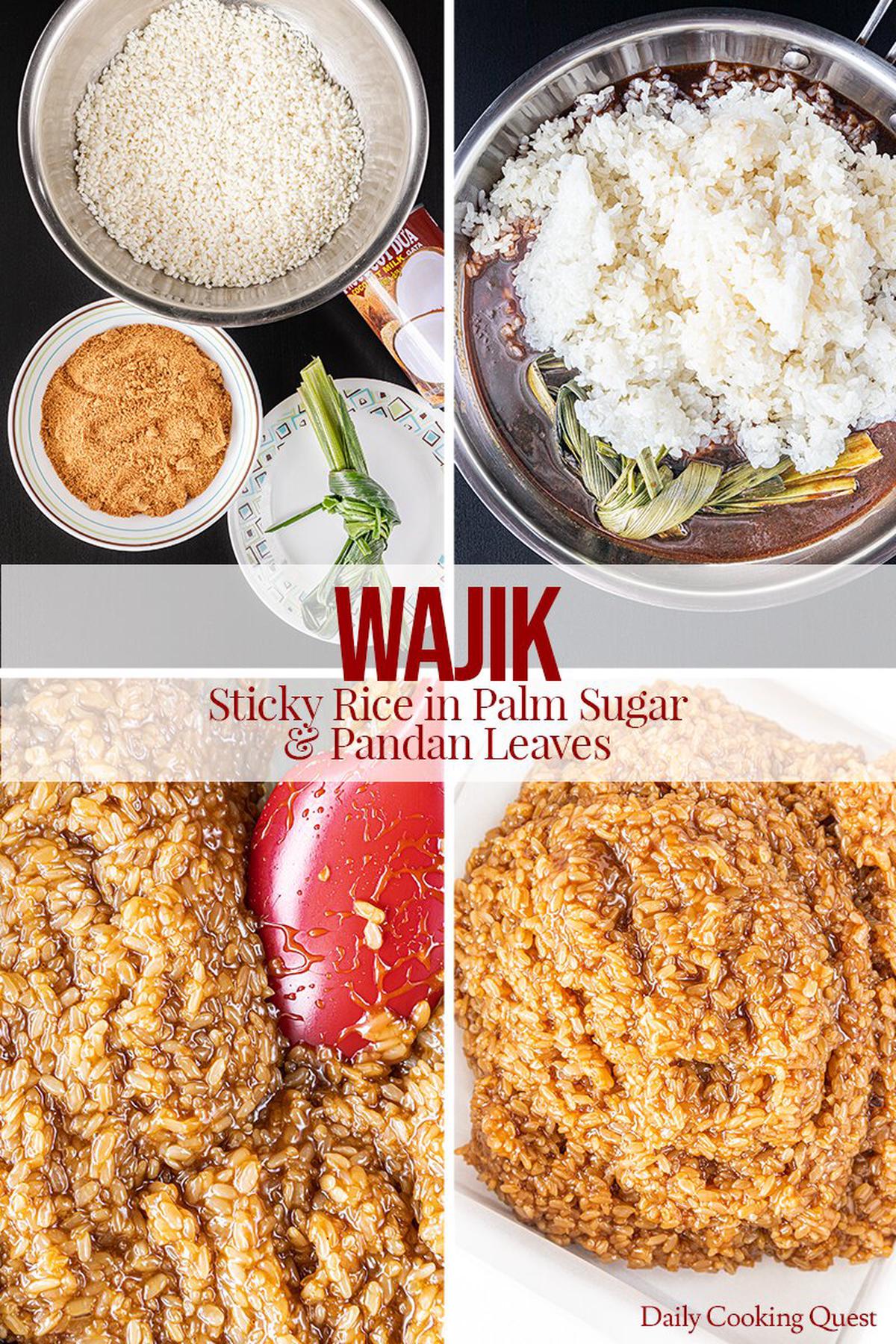
What you need to prepare wajik (Indonesian sticky rice in palm sugar and pandan leaves).
As far as Indonesian snack/dessert/cake recipe goes, wajik is one of the simplest one to prepare. You need only 4 ingredients:
- white sticky rice (white glutinous rice)
- palm sugar
- coconut milk
- fresh/frozen pandan leaves
All four ingredients are critical and should not be substituted with anything else. Well, if you must, you can use black sticky rice (black glutinous rice) instead of white sticky rice, but you absolutely need the other three ingredients and these three should not be substituted at all.
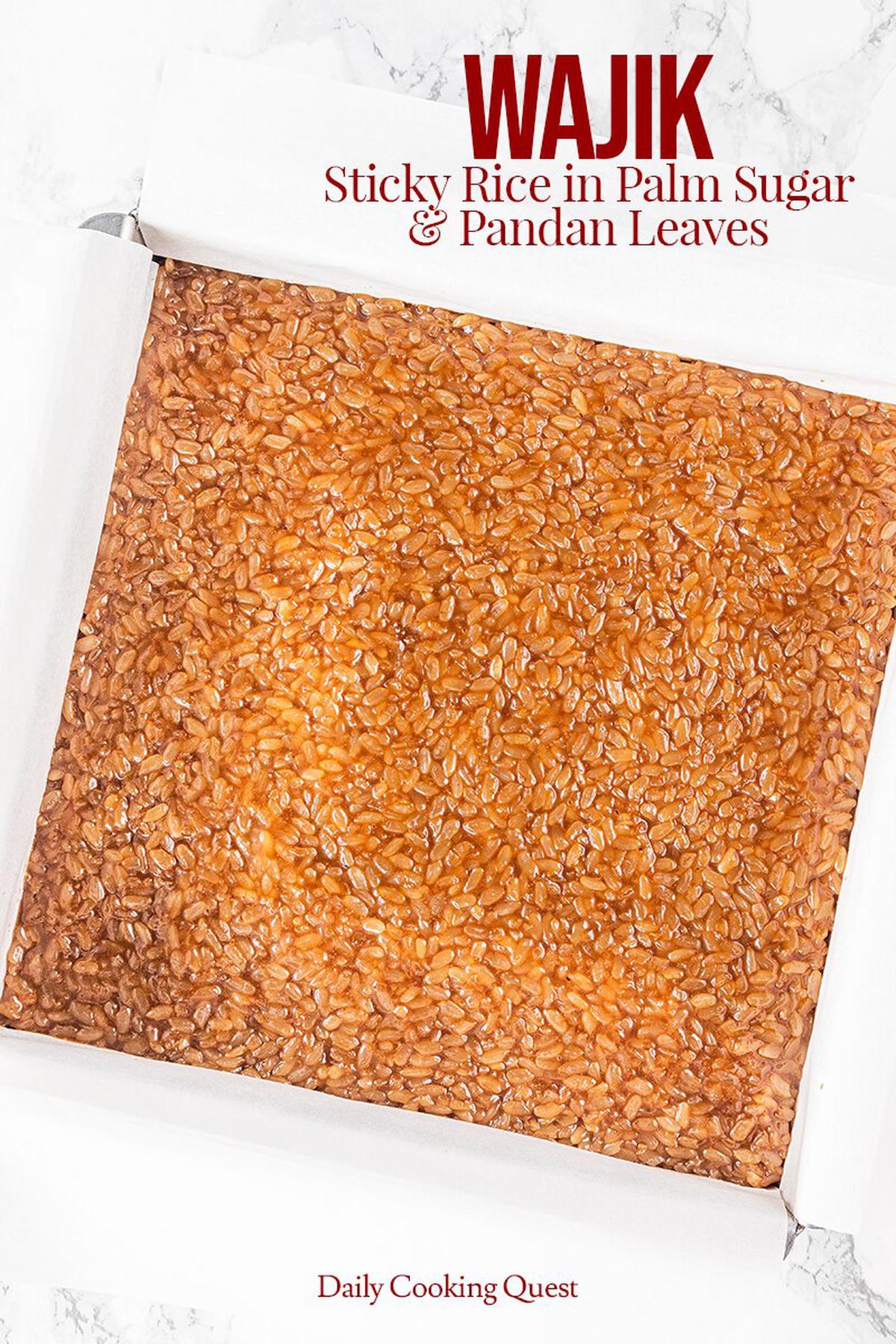
A steamer and how to properly steam sticky rice
To make wajik, you will need a steamer to steam the white sticky rice. You can use a bamboo steamer, a stainless steel steamer, or even the steamer basket that comes with your rice cooker if it is large enough to hold the rice. Regardless of choice, here are my tips for successfully steaming sticky rice:
- Make sure there is enough water in the bottom pot for around one hour of steaming. I would suggest about 2" of water in the bottom pot.
- Make sure that the water is already boiling and there are plenty of steam visible before steaming the sticky rice.
- Just to be safe, line your steamer basket with either a clean kitchen towel, or a parchment paper riddled with tiny holes (smaller than the size of sticky rice) before you add the sticky rice. You don’t want the sticky rice to all end up falling down into the bottom pot instead of staying in the steamer basket.
- Make sure to steam the sticky rice until al dente (soft and tender to bite). I cannot stress this point enough. Since I cannot be sure that we all have the same temperature on our stoves and depending on the size of your steamer (and hence the depth of the rice), steaming time will vary. To test for doneness, grab a tiny spoon of steamed rice and eat it. If you like the texture, then that’s when you should stop steaming. Just for reference, on my 8" stainless steel steamer pot, I need 1 hour of steaming over medium high heat.

How to serve wajik
Like I mention earlier, wajik means diamond, as in the diamond suit in a pack of cards. The cake gets its name from this particular shape, so be sure to cut them into diamonds instead of squares or rectangles.
Wajik is always served at room temperature, so although you can refrigerate any leftovers, be sure to take them out from the fridge and only serve them once they have return to room temperature.
Wajik - Sticky Rice in Palm Sugar and Pandan Leaves
Ingredients
- 400 gram white sticky (glutinous) rice (Indonesian: beras ketan putih), soaked for at least 2 hours or overnight
- 50 ml hot water
- 250 ml coconut milk
- 200 gram palm sugar (Indonesian: gula Jawa), shaved or chopped to small pieces
- 3 pandan leaves (Indonesian: daun pandan), knotted
- Tools
- 8 inch square (i.e. 20 cm square) baking tray
- parchment paper, or saran wrap
Instructions
- Prepare a steamer over medium high heat with at least 2 inch of water in the bottom pot. Line the steamer basket with kitchen towel/parchment paper riddled with small holes that are smaller than the size of the sticky rice.
- Place sticky rice in the steamer basket, and steamfor 30 minutes. After 30 minutes, sprinkle the rice with the 50 ml of hot water. Continue steaming for another 30 minutes.
- Meanwhile, boil coconut milk, pam sugar, and pandan leaves in a pot over medium heat. Reduce heat and simmer for 10 minutes, stir to make sure that the palm sugar dissolves. Strain, discard the pandan leaves and all the impurities. Return the strained liquid to a large skillet/frying pan.
- Once the sticky rice has finished steaming, transfer the rice into the skillet/frying pan containing the palm sugar syrup. Cook on low heat, stir until the liquid is fully absorbed by the rice and is somewhat dry.
- Prepare a baking tray lined with parchment paper/saran wrap, then transfer the rice into the tray. Press and flatten the rice with a spatula as best as you can. Let it cool at room temperature, this should take about 1 to 2 hours.
- Once it has cooled sufficiently, cover the baking tray with a cutting board. Please use a cutting board that is bigger than the baking tray. Flip the rice onto the cutting board, and cut into small diamond/rhombus/parallelogram shapes.
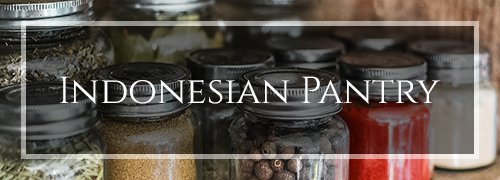

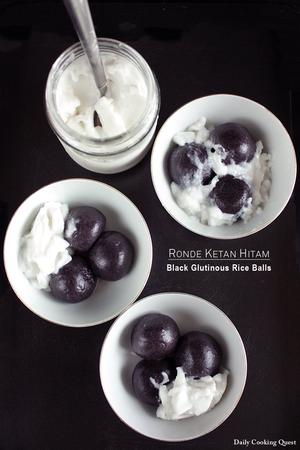

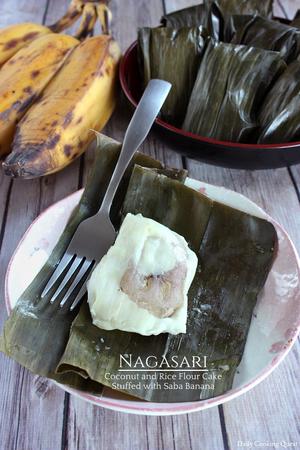
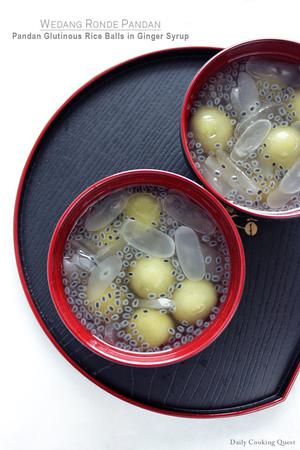
Comments
Hi Anita, if I want this wajik to be sweeter, can I double the amount of palm sugar? will it affect the consistency of the wajik, meaning will I be still able to cut it into perfect diamonds? Thanks.
Hi Ann, you are welcome to add more palm sugar as needed. It should not affect the consistency at all :)
Good morning Anita, I have been doing wajik for few years but I have always seem to have this problem.The glutinous rice becomes hard after being added to the palm sugar mixture,is there any way to make it softer.The method that I have been using is exactly the same as your instruction but I still couldn't figure it out,thank you for helping me
Hi Vikneswaran, it can mean that the steaming time is not enough, or not enough hot water is sprinkled onto the wajik during the steaming period. My Mom always told me that the steaming time varies depending on the heat, so it is actually better to only stop steaming once the glutinous rice is soft to your liking, and only then proceed to add it to the palm sugar.
Hi Anita, i have 2 queries. 1) If i want to double the recipe, should i double all the given ingredients accordingly and 2) is your wajik the soft type because some of the wajik that i bought from the stalls are rather hard. Sorry i didn't have the time to try your recipe yet but i'm planning to do it in the next few days and your reply will be a tremendous help to me. Hope to hear from you soon. Thanks and God bless.
Hi Ann, yes you can double the recipe. As for the texture, it should be not too hard and not too soft (think "al dente" when pasta is done right) :)
Hi Anita, just made your delicious wajik recipe today with great success thanks to my Philippine friend. A couple of minor changes & addition was made so that we could replicate her mother's old recipe. We peeled the skin from a small lime (calamondin) and cut the pieces very fine. This was added to the coconut milk mixture. We used fresh squeezed coconut for the excellent milk. The pandan was also fresh from my garden. We cooked the coconut mixture longer than 10 minutes--more like 15-20, until the bubbles had become small and were uniformly bubbling over the entire surface. Then we removed about 3/4cup liquid from the mixture before adding the rice so that we might be sure it was the correct amount. More can sauce can then be added if necessary, but we didn't need to. Your recipe was wonderful and everyone loved it--thank you!
Hi Gina, glad everyone loves the recipe :) I have never tried adding calamondin into wajik, but it sounds so interesting.
Ok people I love wajik but has never made it Do I cook the rice place in fridge and then go back to the steps
Hi Alana, you can cool the cooked rice in the fridge once it is placed in a mold (e.g. baking dish, baking tray, cake pan, e.t.c.) as described in step 4. Then, when the wajik is cool, or even cold, gently remove from the mold and cut with a knife. If you oil your knife first before cutting, it won't stick to the wajik. I hope this helps. Ah, wajik is served at room temperature, so if you chill it in the fridge, be sure to return it to room temperature prior to serving.
Hello Anita. I wish I can fully appreciate you for sharing your knowledge about wajik sticky rice on this post. I prefer to use the bamboo steamer because it does well on my rice and it also keeps the nutrients to a desirable degree. But I would like to ask if the water in the bottom pot will enter the steamer or not? Thanks again,i”ll be expecting your answer soon.
Hi Kafeimei, sorry for the late reply. The water from the bottom pot should not touch the bamboo steamer at all. In fact, irregardless of the kind of steamer you use, always make sure that the water does not reach the steaming basket/pot. I hope this helps.
Thanks for the great recipe, am salivating already.
I love your website and I can really use the help to recreate my mother's and other Indonesian delicacies. I hope you will keep up your incredible work!
Aww, thank you so much for your kind words, Tammy. This makes all the time I put into this blog worth it. :)
These are my new favorite snack! I am always craving something sweet when I get home from work, and these are the perfect, carby, tasty, treat. And those pandan leaves infuse such a great flavor!
I love everything that has pandan in it. They have such wonderful fragrance, especially in desserts. :)
I'm addicted to this!
Me too. I make this all the time, which annoys my hubby, though he never fails to end up eating most of these! He wants me to make other desserts too. :D
This was so tasty and so easy to make!! Love that the rice is cooked in coconut milk. Yum!
First, I love your pictures! I would like to get at least one diamond right now. Second, I am in love with this dessert. Cannot wait for a weekend to make it! Thanks for sharing.
Thank you, Irina. Have fun with this recipe this weekend. I'm willing to bet you won't be able to stop with only one diamond. ;)
This looks like such a great sweet treat for a mid-day snack!
I want to ask if this recipe works without steaming the rice. I am thinking to stove cook glutinous rice (presoak) until the right consistency then add pandan infused coconut milk and Palm sugar. Would this work? Kind of like making rice puding but less liquid.
Hi Gaby, I have never tried other methods to cook sticky rice beside steaming. I tried looking at articles around the web, and this one from The Spruce Eats may be the solution without steaming ( How to Make Sticky Rice). If you own a colander or a strainer in your kitchen, you can still steam the rice though if you follow the guide on Food 52 (The Best Way to Make Thai Sticky Rice (No Fancy Basket Required)).
Hi Anita, I have enjoyed reading your recipes. Thank you for taking the time to create your wonderful blog! May I ask where do you buy pandan leaves in Minnesota? Thank you!
Hi Shirley, In Rochester, I can find them in from Asian Pacific Market in the North Rochester, and Asian Food Store in the downtown area. I'm not sure where in other cities in MN since I don't live there, though I imagine it should be so much easier in bigger cities like Minneapolis or St. Paul.
Hello Anita, after cooking the Wajik, for how long can we leave it outside instead of putting it in the fridge? & let's say, if I store it in the fridge, how many days can I keep it and if I dont store it in the fridge, how many days can I keep it? Thk you
Hi Saro, it can stay fresh for up to 2 days if stored at room temperature (in a container, not just out in the open), and it should stay fresh for up to 1 week in the fridge.
Hi dear... i made wajik yesterday . It sll turned to be so good .. Except that it was not sweet enough. I would then like to ask u .. If i were to re cook the wajik today by repeating only the process of cooking the coconut milk and the palm sugar . Then put in the wajik which i had already prepared .. jus to add to get it sweeter. Will this affect the texture or any side effect to my Wajik. Pls advise asap. Tq and have a pleasant day ya! Happy new year....
Hi Sharmila, I've never tried that, but I think it is doable. The only trouble is the wajik may no longer be able to absorb additional liquid, and ends up too wet.
Dit was heerlijk. ❤️
Hi Anita. I am glad that I found the right and easy method for wajik. Will give a try soon. But would like to know, if we can cook the rice in rice cooker if steamer is unavailable? Your thoughts…
Hi Devi, it should be doable. If you have ever cooked sticky rice successfully using a rice cooker, then you can do that. Once the sticky rice has finished cooking, you can follow the recipe from step 3 onward.
Hi can I just steam the glutinous rice 1 day or 2 day ahead before making the wajik?
Hi Sally, I have never tried it myself, but I don't see why it won't work. The only problem that may arise is that the rice might have dried out a bit after 1-2 days, so maybe add 1-2 tbsp more coconut milk/water for step 3 if you think the cooked rice is dry.
I just made your wajik recipe and the most difficult part of making this for me is waiting for the pan to cool to room temperature so I can try it! Looks so good! Thank you Anita for sharing your recipe with us 😃
Hi! So unfortunately I cannot find pandan leaves in any of the Asian markets within 50 miles of me. I fortunately found one 30 miles that did however have pandan flavor. I remember my dad would sometimes use it if the leaves weren’t obtainable, but I can’t remember how much to use! Do you have any idea??
Hi Shelby, I have never used pandan flavoring before, but I would guess that a little should go a long way. Maybe try using 1/2 teaspoon?
Leave a comment